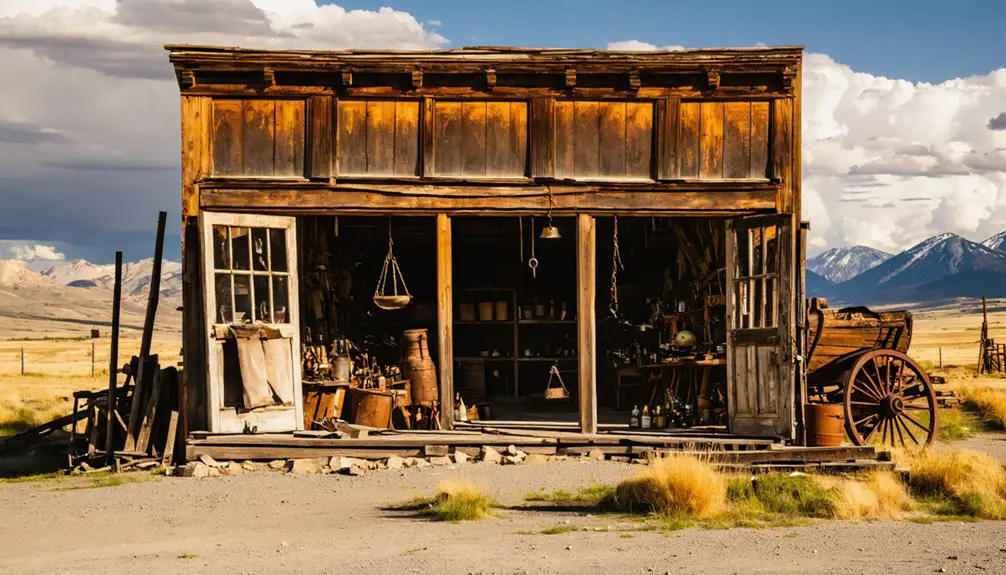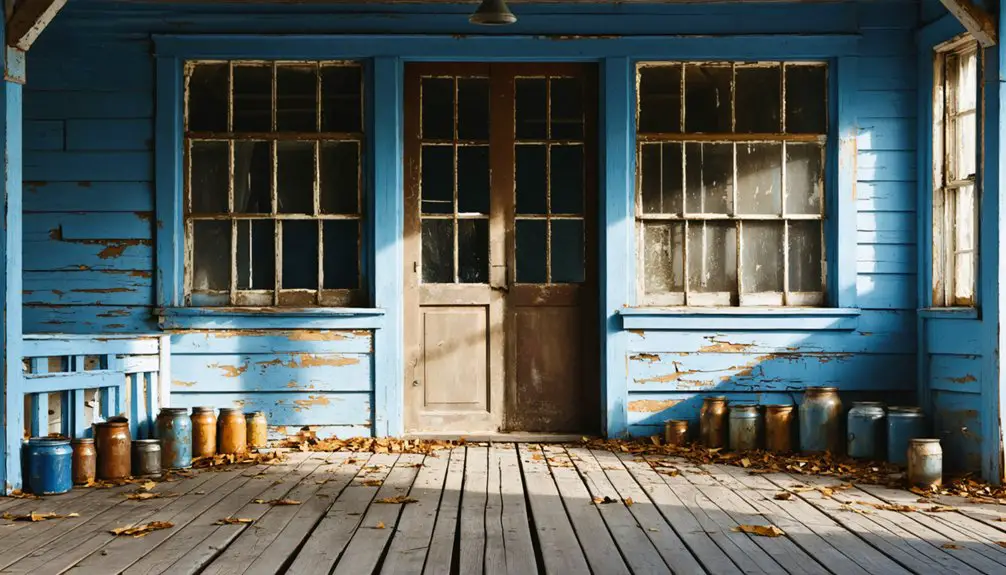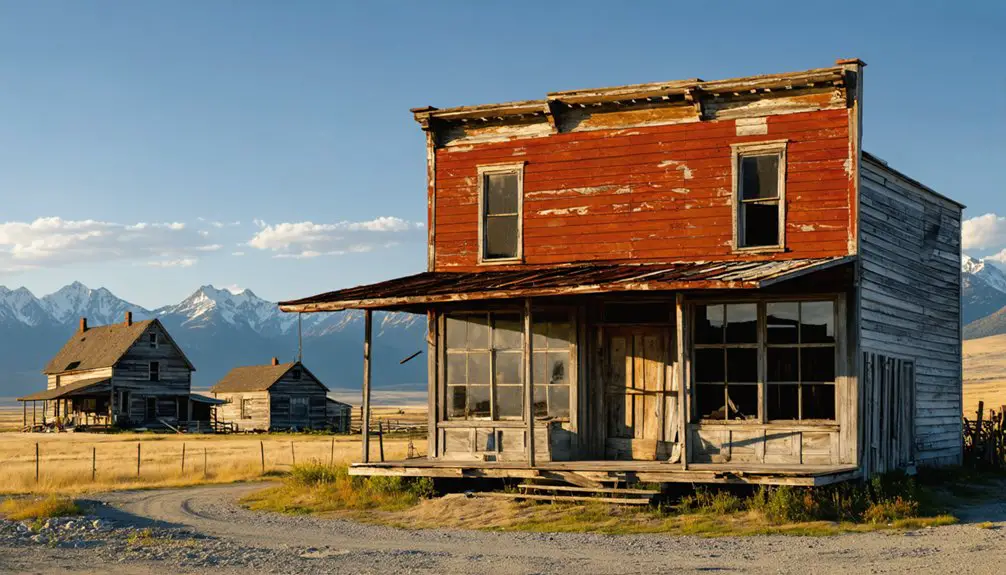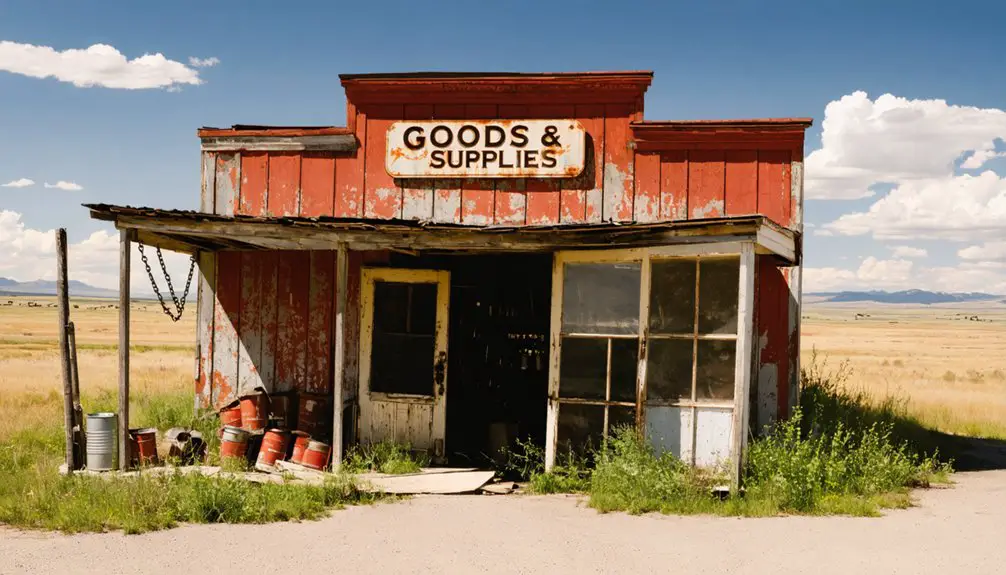You’ll find Wagner nestled in Phillips County’s northern plains, where it emerged during Montana’s 1860s gold rush. This once-bustling mining settlement grew from wilderness to host over 1,000 residents, with more than 100 cabins springing up almost overnight. While miners worked 12-hour shifts extracting gold, a vibrant community life flourished with saloons, dances, and fraternal organizations. Today’s ghost town reveals fascinating layers of frontier life beneath its weathered remains.
Key Takeaways
- Wagner emerged as a gold mining settlement in Montana, featuring a bustling community that reached over 1,000 residents during peak production.
- Located in Phillips County’s northern plains, Wagner sits where the Great Plains meet the Rocky Mountain foothills.
- A devastating fire in 1912 destroyed half the town, contributing to its eventual decline into a ghost town by 1940.
- The town’s layout centered around mining operations, with simple log and frame structures built using local materials.
- Preservation efforts are managed by the Bureau of Land Management to protect remaining structures from environmental damage and vandalism.
The Birth of a Mining Settlement

While Montana’s gold rush era began gradually with Hudson’s Bay Company traders finding gold near Deer Lodge in the 1850s, it wasn’t until the dramatic strikes of the 1860s that mining settlements truly flourished.
You’ll find that each gold discovery sparked rapid development, with camps springing up almost overnight. Within months, you could see more than 100 cabins dotting the landscape, along with essential businesses serving the miners’ needs. Miners often worked long grueling days to earn just a few dollars in gold.
The rush for riches brought both opportunity and challenges. You’d witness miners employing placer mining techniques, working tirelessly with pans and shovels to separate gold from creek gravels. The discovery of gold near Bannack in 1862 marked the territory’s first major strike and set off a wave of prospecting across the region.
Miners endured backbreaking work, sifting through endless streams of gravel in their relentless pursuit of golden dreams.
Despite the harsh frontier conditions and minimal law enforcement, these determined prospectors built the foundations of Montana’s early communities, transforming wilderness into bustling settlements where freedom and fortune beckoned.
Geographic Location and Natural Setting
You’ll find Wagner nestled in the northern plains of Phillips County, Montana, where rolling grasslands stretch toward the Canadian border rather than among the rugged mountain ranges that characterize much of western Montana.
The semi-arid continental climate shapes life here, with cold, dry winters and warm summers that bring most of the region’s modest rainfall. Unlike areas known for precious gems like garnet deposits, the local geology consists mainly of sedimentary formations typical of prairie regions.
The surrounding terrain reflects the typical northern Great Plains ecosystem, featuring mixed grass prairie and gentle hills rather than the mineral-rich mountainous geology found in Montana’s famous mining districts.
Mountain Range Location Details
Nestled in Phillips County’s northern reaches of Montana, Wagner ghost town occupies a distinctive geographical position where the Great Plains shift into the northern Rocky Mountain foothills.
At an elevation between 2,000 and 3,000 feet, you’ll find yourself surrounded by mountain geology that tells the story of ancient volcanic activity and Cretaceous rock formations. Like nearby Rocky Point to the southeast, the area showcases the raw beauty of Montana’s northern frontier.
- The Little Rocky Mountains rise nearby, offering a dramatic backdrop to the town’s remote setting.
- Rolling plains stretch toward the distant northern Rockies, creating an untamed frontier atmosphere.
- The Bears Paw Mountains loom to the south, their silhouette marking the horizon.
- Scattered buttes and outcrops break up the prairie landscape, remnants of volcanic history.
- The Sweetgrass Hills pierce the skyline to the southwest, adding to the region’s rugged character.
Regional Climate Influences
Because of its position in Montana’s northern Rocky Mountains, Wagner experiences a demanding continental climate shaped by dramatic elevation changes and mountainous terrain.
You’ll find significant climate variability throughout the seasons, with harsh winters bringing heavy snowfall and below-freezing temperatures. The surrounding peaks and valleys create distinct microclimates, affecting local precipitation patterns and temperature swings.
Located four miles off the highway, the remote setting contributes to its isolation and exposure to severe weather conditions.
During summer months, you can expect mild days but cool nights due to the town’s elevation of roughly 5,000-6,000 feet. Like nearby primitive cabin rentals, winter visitors must rely on snowmobiles or skis to access the remote ghost town site.
The mixed conifer forests and alpine meadows surrounding Wagner influence local weather conditions through natural windbreaks and moisture retention.
Spring snowmelt feeds numerous mountain streams, while winter conditions often limit access to snowmobile or ski travel only, much like nearby Garnet ghost town.
Surrounding Mineral Resources
Located in Phillips County along Montana’s northern plains, Wagner sits within a region historically shaped by diverse mineral resources and geological formations.
While not a major mining hub itself, the town’s position along the Hi-Line railway corridor made it an important link in the region’s resource management network.
You’ll find evidence of mineral exploration throughout the surrounding area, where sedimentary basins and rolling plains hold stories of Montana’s mining heritage.
- Rich deposits of gold, silver, and copper drew prospectors to nearby regions
- The Great Northern Railway transported valuable minerals along Wagner’s doorstep
- Sedimentary rock formations contain hidden treasures beneath the prairie soil
- Local geological processes created unique mineral-bearing strata
- The Missouri River drainage influenced mineral deposit patterns across the landscape
Life During the Mining Boom
As Montana’s mining industry exploded in the late 1800s, communities like Wagner transformed from scattered frontier settlements into bustling industrial centers.
You’d find a diverse workforce of immigrants drawn by the promise of wealth, working deep underground in challenging conditions.
Mining innovations like Brückner cylinders and reverberatory furnaces revolutionized how you’d extract and process minerals, while extensive shaft systems stretched over a mile beneath your feet.
Life centered around the mines, where you could earn substantial wages as companies poured millions into worker salaries each month.
Yet you’d also witness intense labor conflicts as unions fought for workers’ rights, earning Montana its reputation as “The Gibraltar of Unionism.”
The economic prosperity touched every aspect of daily life, supporting local businesses and helping build the infrastructure that defined these booming communities, with the Lewisohn brothers driving much of the region’s mining development after establishing major operations in 1879.
With production reaching 210 million pounds of copper annually by 1896, mining operations provided jobs for thousands of workers across the region.
Daily Routines and Social Structure

If you’d lived in Wagner during its mining heyday, you would’ve found yourself part of a surprisingly family-oriented community where miners’ families occupied multi-room cabins and participated in social gatherings at venues like Fraternity Hall.
Your daily life would’ve revolved around not just mining work but also community events, from dances to concerts, while women played crucial roles in commerce and education rather than mining labor. At its peak in 1898, the town thrived with vibrant businesses including hotels and numerous saloons. During slower mining periods, residents sustained themselves through timber cutting to maintain their income.
The social fabric was strengthened by fraternal organizations and family-friendly activities, creating a more stable environment than typically found in western mining camps dominated by single men.
Life in Mining Families
Daily life in Wagner’s mining families revolved around the relentless demands of gold extraction and survival.
You’d find a clear division of family dynamics, with men heading to the mines before dawn while women managed households and children balanced mining education with domestic duties.
Family cooperation was essential, often extending beyond immediate relatives to include boarders who shared living costs.
- Your day would start in darkness, preparing simple meals before 12-hour mining shifts.
- You’d stretch every dollar by reusing tools and supplies during lean times.
- Your children would split their time between schooling and helping the family survive.
- You’d rely on your neighbors and extended family for support during tough times.
- Your home would be simple but practical, built for the harsh Montana climate.
Social Activities After Work
The hard labor of mining life gave way to vibrant social gatherings once the day’s work ended in Wagner. You’d find miners heading straight to the saloon to unwind with their coworkers, sharing stories over drinks and card games. The town’s social structure centered around these daily rituals, but it wasn’t all about gambling and drinking.
You could join community dances at the local halls, where families gathered for entertainment and socializing. Recreational activities included bowling, hunting expeditions, and seasonal festivals that brought everyone together.
If you were part of a fraternal organization, you’d attend regular meetings that fostered mutual support and camaraderie. Even private homes hosted informal gatherings, where neighbors would share music, food, and conversation, strengthening the bonds that kept Wagner’s community spirit alive.
Class and Gender Roles
Living in Wagner meant adhering to clearly defined gender roles that shaped daily routines and social structures. The gender dynamics reflected the era’s expectations, with men working long hours in mines while women managed domestic responsibilities. Class disparities were evident in housing arrangements and social influence, creating distinct social tiers within the community.
- You’d find men leaving at dawn for dangerous mine work, while women prepared meals and tended to children’s education.
- Mine owners and successful prospectors lived in larger homes, wielding considerable influence in community decisions.
- Working-class families occupied modest cabins, often supplementing their income through timber cutting.
- Women’s influence grew through church groups and school boards, though men dominated formal leadership.
- Immigrant families worked tirelessly to establish themselves, sometimes facing additional social barriers.
Architecture and Town Planning

While many Montana mining settlements prioritized speed over stability, Wagner’s architectural landscape reflected typical frontier construction methods of the era, with buildings hastily erected using locally sourced materials and minimal foundations.
Hastily built frontier towns like Wagner favored quick construction over permanence, using local materials to meet immediate shelter needs.
You’ll find that building techniques favored simple log and frame construction, utilizing wood from the surrounding area. The town’s architectural influences emphasized function over form, with straightforward rectangular structures housing saloons, stores, and other essential services.
The town’s layout developed organically around mining operations, with buildings clustered near shaft entrances and along primitive roads.
Despite its rough-and-ready appearance, Wagner maintained some civic order through designated spaces for schools, churches, and other community buildings, though many of these structures have since succumbed to decay and Montana’s harsh elements.
Economic Rise and Decline
Following the discovery of rich gold-bearing quartz veins in the 1870s, Wagner’s economy surged as miners flocked to the area after exhausting nearby placer deposits.
The town’s economic fluctuations mirrored the broader Montana mining landscape, where success depended on mining technology and market forces.
You’ll find Wagner’s economic story marked by these dramatic shifts:
- From humble beginnings to a bustling population of over 1,000 during peak gold production
- A thriving business district with hotels, saloons, and stores serving the mining community
- The devastating impact of the 1912 fire that destroyed half the town
- A brief revival during the 1930s when gold prices rose during the Great Depression
- The final decline by 1940 as mining became unprofitable and wartime demands drew residents away
Transportation and Access

Although modern visitors can reach Wagner via Montana Highway 200, accessing this historic ghost town requires careful planning and consideration of seasonal conditions.
You’ll want to take Garnet Range Road south at mile markers 22-23, traveling roughly 11 miles to the parking area. Road accessibility varies considerably by season, with the dirt road being passable for standard vehicles from late spring through early fall.
For vehicle recommendations, stick to the primary route from Highway 200, as the alternative US 90 approach isn’t suitable for most drivers.
You’ll find the main road washboarded with potholes, so higher-clearance vehicles work best in wet conditions. Don’t attempt to bring RVs or trailers.
During winter months, you can only reach Wagner by snowmobile or skis, as roads remain closed to vehicles.
Notable Buildings and Landmarks
Once you arrive in Wagner, you’ll encounter a fascinating collection of historic structures that tell the story of this once-bustling mining settlement.
Like other Montana ghost towns such as Garnet and Bannack, Wagner’s remaining buildings reflect the vibrant social and industrial life of a frontier mining community.
- Historic saloons stand as reminders of where miners gathered after long workdays, sharing stories and seeking entertainment.
- Mining buildings, including processing mills and shaft structures, showcase the town’s economic foundation.
- Simple wooden cabins and family homes reveal the daily lives of the mining community.
- Commercial structures like general stores highlight the town’s self-sufficient nature.
- Public buildings demonstrate how Wagner grew from a mining camp into an organized settlement.
Present-Day Preservation Status

As Montana’s historic ghost towns face ongoing preservation challenges, Wagner benefits from a network of dedicated organizations working to protect its remaining structures.
The State Historic Preservation Office provides grants and legal protection under the Montana Antiquities Act, while local preservation groups coordinate efforts to stabilize buildings and prevent further deterioration.
You’ll find Wagner’s current preservation status reflects the delicate balance between maintaining historical authenticity and supporting visitor engagement.
Like other ghost towns in the region, it faces threats from natural weathering and occasional vandalism. The Bureau of Land Management and preservation societies monitor the site closely, implementing protective measures to safeguard original materials and architecture.
While some structures show signs of age, preservation efforts focus on keeping Wagner’s historical fabric intact for future generations to experience.
Frequently Asked Questions
Were There Any Famous Outlaws or Notable Crimes in Wagner’s History?
You’ll find the trail runs cold on outlaw legends and crime tales specific to Wagner, though nearby areas saw action from the Wild Bunch gang and Henry Plummer’s notorious road agents.
What Happened to the Residents’ Belongings When They Abandoned the Town?
You’ll find many abandoned possessions were left to decay, while residents took lighter items when fleeing. Lost artifacts remain scattered in collapsed buildings or were taken by scavengers over time.
Did Any Major Fires or Natural Disasters Affect Wagner?
You’ll find the biggest fire impacts hit in 1912, destroying half the town’s business district. Besides that devastating disaster, you won’t find many major calamities until 2021’s Anderson Hill Fire nearby.
Are There Any Documented Ghost Stories or Supernatural Occurrences?
While you might expect ghostly tales from a historic railroad town, there aren’t any documented ghost sightings or paranormal investigations in Wagner – its legends focus on Butch Cassidy’s train robbery instead.
What Native American Tribes Originally Inhabited the Wagner Area?
You’ll find that the Salish, Pend d’Oreille, and Kootenai peoples primarily inhabited this area, with Blackfeet and Nez Perce tribes also using nearby lands for hunting and seasonal activities.
References
- https://www.garnetghosttown.org/history.php
- https://avrextravel.com/montana-ghost-towns/
- https://www.youtube.com/watch?v=SrgN3PDtxyI
- https://southwestmt.com/ghosts/ghost-towns/
- https://visitmt.com/things-to-do/ghost-towns
- https://mhs.mt.gov/education/textbook/chapter6/Chapter6.pdf
- https://archiveswest.orbiscascade.org/ark:/80444/xv28731
- https://dp.la/exhibitions/industries-settled-montana/mining
- https://montanakids.com/agriculture_and_business/mining/Early_days_of_Mining.htm
- https://archiveswest.orbiscascade.org/ark:80444/xv647063



